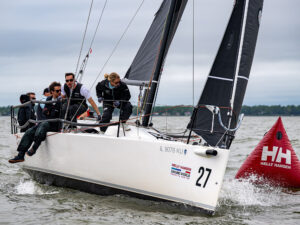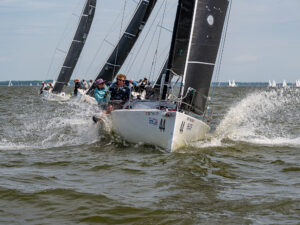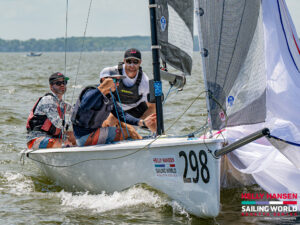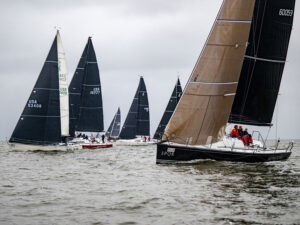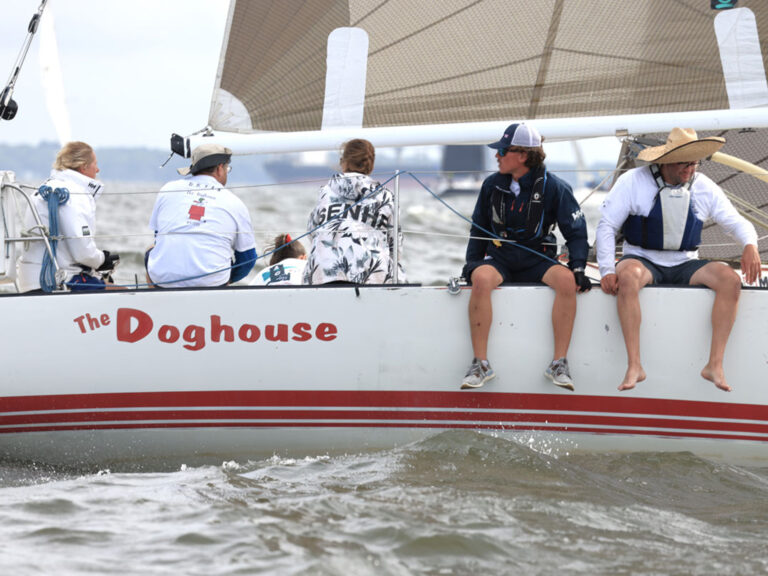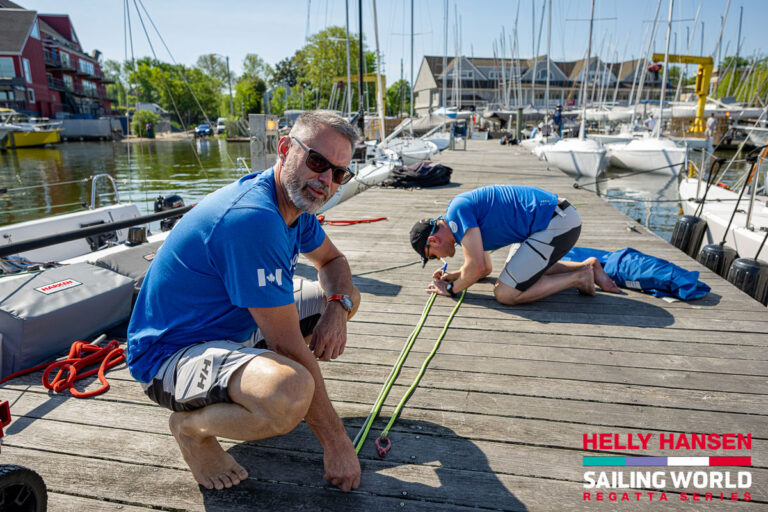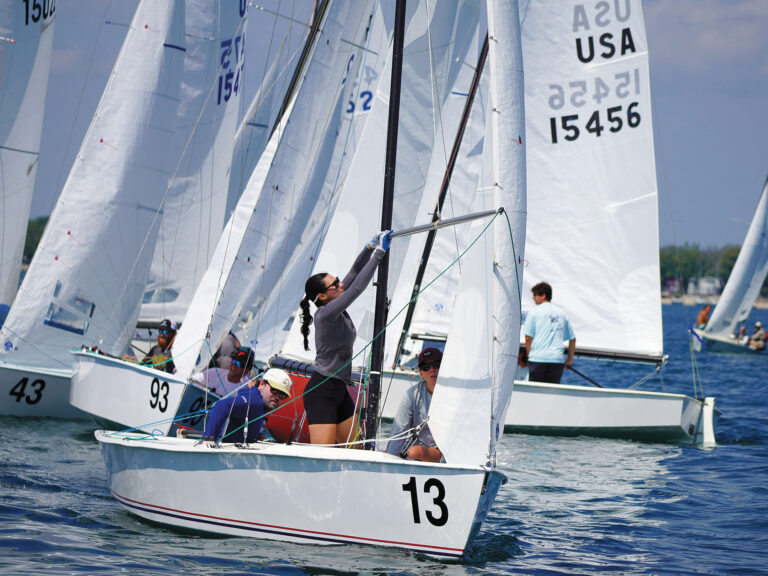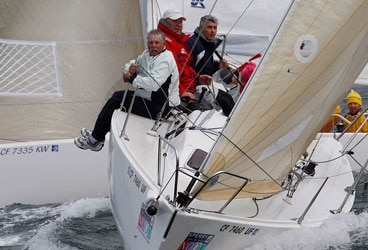
2010SanDiegoHP368
Class Coordinators
Waiver Form (Bring to On-Site Registration)
Discount Accomodations
March 23
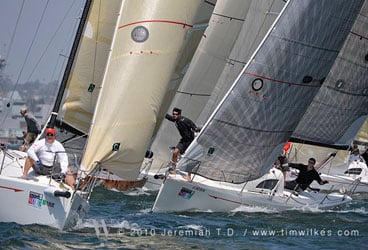
Jeremiah T.D./ www.timwilkes.com| |The 13-boat Flying Tiger 10-Meter division enjoyed three days of close-quarters racing at the 2010 Sperry Top-Sider San Diego NOOD.| Flying Tigers Taking Off in SoCal
When Tom Hirsh took the reigns from previous Flying Tiger builder Bill Stevens in December, he knew how important it was to keep the class’s independent spirit alive. “Sailors are an independent lot to begin with,” he says. “But we know it has to be about more than just straight racing. Not everyone can be on the podium, so here in Fleet 1 we’ve made a big effort to increase the socialization, make it a more friendly class where people help each other out. That’s had a real positive effect on the class.”
At the San Diego NOOD, the 13-boat Flying Tiger 10-Meter division made its home base at Coronado YC, where boats rafted up alongside one another. On Saturday night, the group hosted a BBQ boat-hop. “That was probably the highlight of the weekend for me,” says Hirsh. “The owners all mostly know each other, but the crews don’t, necessarily. Seeing them mingle was really cool. We’ve had several socials, but nothing quite as large as this. We probably had 80 people there-sailors, wives, girlfriends. Everybody was moving around from boat to boat, and the party went late into the night.”
Southern California’s Fleet 1 is the Flying Tiger 10-Meter’s largest. There’s a strong contingent on the East Coast and in Australia, too. “The fleet that’s really growing is in Atlanta,” says Hirsh. “A year ago, it only had one boat. Now there are four.”
While Hirsh doesn’t have an extensive boatbuilding background, his experience maintaining the fleet of charter boats at his Harbor Island Sailboats-a sailing club and instructional facility on San Diego Bay-gives him a solid understanding of what makes a sturdy boat. With the help of designer Bob Perry, he’s making a few tweaks to the 10-meter. “I’m not a boatbuilder by trade, but I did stay at a Holiday Inn Express last night,” jokes Hirsh. “A lot of guys in the class made it clear that they desire a change from the casette-hung rudder, so we’ll be unveiling a new rudder prototype in May. It’s important to us to keep the class growing as a one-design, so we’re doing our best to communicate with the class about any changes.”
Hirsh raced in the NOOD with his sons Kyle (23), Kevin (21), and Keenan (19); Chris Winnard’s Dangerous When Striped won the division with five first-place finishes. “We had three days of good, steady racing,” says Hirsh. “In this class, five or six of the boats have a good chance of winning any race. Going into the first weather mark, there’s a stack-up seven boats deep. It’s a fence line-you just can’t get through.
“It’s a relatively new class,” continues Hirsh, “but it’s made up of very experienced sailors. The 10-Meter is by no means an entry-level sportboat.”
The 10-Meter may be a bit frisky for beginners, but the new Flying Tiger 7.5 Meter could prove an excellent training platform. “It’s a sweet, user-friendly boat,” says Hirsch. “You can sail it with two-people, but you usually race with four. It doesn’t have the waterline of a 10-meter, but it’s still got some performance characteristics. There’s an 800-square-foot gennaker, so it’s got some power off the wind. There’s a huge cockpit, a fathead main, no backstay, a bulb keel with plenty of ballast, and a bit of a chine in the aft section. We’ve taken delivery of two of them here in San Diego, and the plan is to get the fleet off the ground through the charter program at Harbor Island.”
Given the Flying Tiger 10-Meter’s success in Southen California, it can’t be long before we see a 7.5-Meter division at the San Diego NOOD. They’ll certainly get a warm welcome from the Flying Tiger family.
-Michael Lovett
March 22
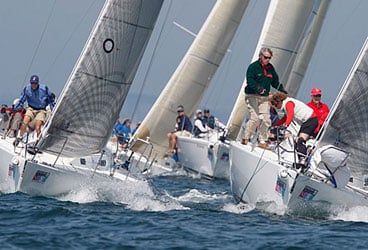
Tim Wilkes / www.timwilkes.com| |Thanks to a thriving Southern California fleet, the J/105 class fielded the largest division at the 2010 Sperry Top-Sider San Diego NOOD.| Javelin Spears Near-Perfect Victory
When the gods of sailing created the yacht club, they must have had programs like the J/105 Javelin in mind. San Diego YC serves as home base for the Doug Werner’s team, which includes his wife, Pam (foredeck), the club’s commodore, Bill Campell (tactics), Campbell’s wife, Sherri (pit), and friends John Dennis (mast) and David Bishop (trimmer).
This cohesive group of friends and spouses races competitively and takes full advantage of the club’s social opportunities. Javelin is what yacht clubs were made for. “It’s a fun group,” says Campbell. “We may not be the youngest team out there, but we can go out and sail and be competitive. The J/105 pushes us to the top of our strength range.”
“We do a lot of stuff together off the boat,” adds Werner. “The club is kind of the center of that. Sailing is the focus, but it’s not the only part of it. We enjoy each other’s company and we enjoy the people around yachting and each other’s families, that sort of thing.”
While they may embrace the yacht-club lifestyle, it’s not like they wear their blue blazers out to the racecourse. Javelin is a serious racing program, a frontrunner in Southern California’s thriving J/105 scene. “From Santa Barbara to Long Beach down to San Diego, there are a lot of good boats and they all try to support each other, traveling to regattas at each other venues,” say Campbell.
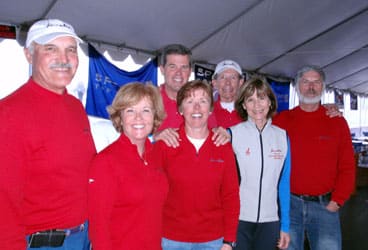
Michael Lovett| |The crew of the J/105 Javelin includes (from left) Doug Werner, Pam Werner, Bill Campell, Sherri Campbell, John Dennis, Linda Snyder, and David Bishop.| At the San Diego NOOD, the majority of the 17-boat J/105 fleet was composed of San Diego boats, and aside from Blane Shea’s Striking team, all the crews were familiar with the venue. There wasn’t much home-field advantage to be had. “We know we’re not going to win all the time, but we always go out and try our best,” says Campbell. “Some weekends are better than others, and we had a really good weekend. The breaks went our way, the shifts went our way. That doesn’t happen every weekend, but this weekend it happened to us. We were able to get off the line, go where we wanted to go, and, for the most part, once you get out to where you want to be, things start to go your way.”
And man, did things ever go Javelin’s way: The team won four of five races to take home first place in the division and first place overall. The victory secures Werner’s crew a spot in the 2010 Sperry Top-Sider NOOD Championship, a weeklong affair sailed in Beneteau 39s in the British Virgin Islands in November.
“What a way to start the sailing season,” says Werner. “We’ve been sailing together for about five years now, and it seems like it’s all starting to come together.”
In San Diego this weekend, the yachting gods were smiling on Javelin, and Javelin was smiling back.
-Michael Lovett
For the NOOD Addicts
Check out these on-the-water updates courtesy of SDYC’s Jared Wohlgemuth.
March 20
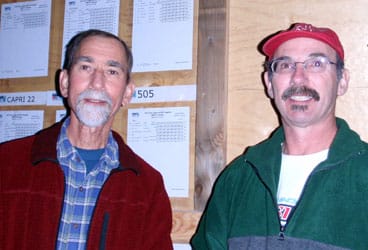
Michael Lovett| |For lake sailors Jerry Lewis (right) and Jeremy Gicker, the Capri 22 racing in San Diego is presenting an ocean of new challenges.| From Gold Country to NOOD Country
The best aspect of the NOOD regatta concept, I think, is the way the events bring together all different types of sailors. Here in San Diego, with 17 one-design classes competing, you get to meet racers from all across the board. I spent two days sailing on Bo Kopaniasz’ Beneteau 36.7 Sorcerer with a fun-loving group of locals who jump at every chance to get out on the water, whether for a run from Newport to Ensenada, a weeknight beer-can race, or just to blast around the bay on a Laser when the wind is really honking.
At the tent on Saturday night, I met another group of sailors who are similarly stricken with the racing affliction. Jerry Lewis, Jeremy Gicker, and Rick Paulson race the Capri 22 Kudzu out of Gold Country YC in historic mining town of Grass Valley, Calif. “People always remark how sailing’s such a slow sport,” says Lewis. “But I tell them, ‘You don’t understand. It’s a fast slow.’ That’s why I call my boat ‘Kudzu’-the kudzu vine is the fastest growing plant. It’s a fast slow.”
Lewis acquired his boat when the Alameda Naval Base on San Francisco Bay closed and donated its fleet of Capri 22s to Gold Country YC. “My boat was the one we stripped all the parts off of to fix up the other boats,” explains Lewis. “I was supposed to take a chainsaw to the boat and put it in the trash, but I just couldn’t bring myself to do it.”
For years, Lewis and Gicker raced against each other in their salvaged Capri 22s on the mountain lakes of Northern California, frequently taking first and second place. When Gicker’s crew jumped ship, the rivals teamed up to form a supergroup of sorts-a supergroup that’s finding new challenges in the open-ocean conditions off San Diego. “We’re lake sailors,” says Gicker. “We’re used to sailing triangular courses where every leg is a beat. We’re used to the wind shifting all over the place. Out here, it’s taking a while for us to get comfortable with the fact that you can tack on the layline and set the pole and not have to worry about the wind shifting on you 15 feet from the mark!”
As they take to the ocean, these lake sailors haven’t left behind all their familiar habits. They’re used to roughing it, accommodations wise, at most regattas, anchoring the boat near shore on a quiet mountain lake and sleeping aboard, or camping on the grounds of the host club. In San Diego, they passed on the pricey hotel rooms and opted to pitch a tent in a nearby campground. “You should see the place,” says Lewis. “There’s a hookup for cable TV, wireless internet, the works. I don’t even have cable at home. This is the lap of luxury. I should have brought by TV.”
Have they sailed in the NOOD before? “No, we usually wear clothes,” says Lewis. (Having worked at Sailing World for four years now, I’ve heard my fair share of nudity puns in reference to the NOOD series, and I should have seen that one coming. But I didn’t, and for some reason, Lewis’s quip struck me as the best one yet.)
“This is our first NOOD regatta, and we really like it,” Lewis continues. “I’m a PRO myself, so I know what’s involved with running good races. It’s been great listening to the race committee chatter over the radio; it keeps us well informed. As first timers, it just gives us one less thing to worry about.”
The Grass Valley gang’s only complaint is one shared by many under the tent. “I just wish there were a few more boats in our fleet,” says Lewis, whose sits in fifth-place in his 7-boat division. “And I wish we were beating a few more of them!”
Something tells me that if this were the Grass Valley NOOD, Lewis would get his wish. And he wouldn’t have to deal with the biker gangs revving their engines outside his tent.
-Michael Lovett
March 19
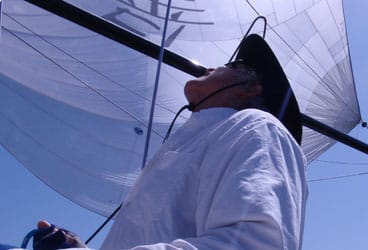
Michael Lovett| |Josh Lippitt trims the kite aboard Bo Kopaniasz’s Beneteau 36.7 Sorcerer on Day 1 of the 2010 Sperry Top-Sider San Diego NOOD.| It’s the Climb
In sailboat racing, as in so many pursuits, it’s not about where you begin, it’s about where you finish. On Bo Kopaniasz’s Beneteau 36.7 Sorcerer, Day 1 of the 2010 Sperry Top-Sider San Diego NOOD was one of steady progress. I rode along as honored media crewmember-my biggest contribution was holding out the boom on the runs, or perhaps it was fetching waters in between races-so I had a front-row seat for the team’s swift ascent of the learning curve.
We had great starts all day, thanks to tactician Larry Emerson’s aggressive play-calling. In Race 1, however, our boatspeed was lagging, and we found ourselves on the wrong side of a left shift that left us at the back of the pack.
Not to worry. In between races, the gang regrouped, selected a crispier genoa, and entered the starting sequence with a fresh outlook. Race 2 saw improved communication, which, on the runs, helped the team nurse the boat down the large swells rolling in from the northwest, and on the beats, helped keep the boat moving through frequent changes in velocity. By the final beat, we had worked our way into the middle of the fleet, and we were on the move.
While waiting for the J/24s to finish, Sorcerer continued adding spice to its increasingly magic potion. Trimmer Josh Lippitt suggested that Kopaniasz try steering from the low side, which would give him a better view of the sails, given all the bodies obscuring the view from the high side. Emerson lined up another bold start; when the gun sounded, we were leading the starboard-tack pack at the pin, and we slowly worked to weather on the competition. We missed the first shift, however, so we were mid-fleet at the weather mark. As the wind began to soften, the runs became increasingly delicate affairs. Thanks to nimble foredeck work by Mark Freed and Jim Darroch, and responsive driving by Kopaniasz and the trimmers, we came into the leeward mark within striking distance of the leaders. The breeze filled in again towards the top of the second beat, and we managed to pick off Steven Ernest’s Aimant de Filla. A third-place finish in the race kept the scoreline slanted upwards.
As we turned towards the dock, there was the sense that things were headed in the right direction, reinforced by that lovely popping sound that accompanies the cracking of cold beers. The sun was slipping down on a spectacular day of racing off Point Loma, and all was well with the world. Our world, at least.
-Michael Lovett
The West Coast Likes the Weta
At the post-race party at San Diego YC, I met up with Dave Berntsen of Weta West. As the West Coast distributor for the Weta trimaran-winner of Best Dinghy in Sailing World’s 2010 Boat of the Year contest-Berntsen is fostering the rapid development of a healthy one-design fleet for this 14-footer. Bernsen has already sold 15 boats this year, and he has orders for 20 more. The success of Friday’s Weta demo day could add to those impressive numbers.
Berntsen introduced me to Bob Shirley, a veteran small-boat racer from Ventura, Calif., who bought his Weta a little over a year ago. “It’s a fairly easy boat to learn, even for someone who has never sailed multihulls,” says Shirley. “It sails more like a monohull with outriggers.”
Shirley appreciates the convenience of racing his Weta. He tows a simple flatbed trailer, onto which he straps the boat in its dolly. “You can launch the boat anywhere, and you don’t even have to get the trailer wet,” he says. “You can be out blasting around in a matter of minutes.”
John Rizzi, from San Jose, Calif., purchased his Weta three weeks ago. The San Diego NOOD is his third regatta in as many weeks. “I also own a Tripp 40,” says Rizzi. “But the Weta is just so incredibly easy to campaign, I can see myself doing a lot more racing.”
Berntsen sees the Weta’s appeal as a function of the current economy. “A lot of people have downsized,” he says. “As the economy begins to turn around and people start thinking about getting back out on the water, the Weta makes a lot of sense.”
With a sail-away price less than $10,995, the Weta affords a sizeable bang for the buck. And with fleets cropping up from San Diego to Seattle-the largest is currently in San Francisco, where Berntsen lives-there are more and more opportunities to race these user-friendly trimarans against like-minded speed freaks.
-Michael Lovett
March 17
Sailmaking Innovation on Display
Greg Lynn’s Beneteau 36.7 Kraken will be using one of the new North 3Di sails. There are about five of these sails in the San Diego area, as our testing for these sails has been California based. As far as I know, the Kraken mainsail will be one of only a couple 3Di sails racing this weekend. I’m the technical director for the North 3DL plan in Nevada, and in charge of the development of this new product. I’ll be trimming said mainsail.
-Bill Pearson, North Sails
Your Chance to Get Weta
We’re planning a Weta demo day on Friday for prospective owners (there are many) and then we’re racing at MBYC on Saturday and Sunday.
-David Berntsen, www.wetawest.com
J/Boats in Full Effect
The J/109s are building their fleet and have a presence at the NOOD. Great Balls of Fire with Daylen Teren is coming out for their first ever High Point regatta at the NOOD. We’re excited about the building momentum
for the J/109 fleet and are looking forward to continuing to develop a strong fleet in Southern California
The J/80s are building their fleet and encouraging participation by welcoming J World club members to join the High Point fun. Four J World boats are being chartered by club members, generating a total of 12 J/8’s at
the NOOD. The fleet is working together with J World to come up with creative ways to build excitement for the fleet and it’s working! J/80 Worlds are in Rhode Island this year, which is also opening up opportunities
not only to build excitement for the class, but also bringing some great deals on the already economical J/80.
J/Concierge (that’s me) is a unique service to the J/Boat fleet, providing support to boat owners who race in the High Point regattas around Southern California. The main goal of J/Concierge is to provide customer service and build fleet participation by helping boat owners find crew, setting up deals on hotels, organizing dive services during regattas, and doing crew weigh ins. In addition, J/Concierge will support J/Boat fleets in new regattas focused on building fleet participation, such as the inaugural J/105 So Cal Championship Regatta last year in Long Beach, and of course the J/Boat only J/Fest! Basically just making owning and racing a J/Boat the only way to go!
-Amanda Denton, JK3 Nautical Enterprises
March 16
You Can Always Count on the J/24s
On Friday morning, the J/24s are having a tech/talk session with Chris Snow. The class has been involved with the San Diego NOOD since the first time it was here. We haven’t always had a class form for the regatta, but there aren’t that many active boats in San Diego. This year, as usual, we have many traveling boats, in fact all but one. It would be nice to see this class have some sort of a revival in San Diego, but I will not hold my breath. We at least have a class in the NOOD and sometimes J/Fest. My boat is in Mexico at the moment-I just finished the Copa Mexico regatta. Chris Snow also did it and finished second (he will be sailing Etchells this weekend, as will I). I will sail on Friday with one of the out of town J/24s.
The J/24 is a great boat for San Diego, but it’s hard to beat the Etchells and J/105s out of the spotlight for one second!
-Ian Trotter, J/24
Capri 22s Upping the Ante
Our fleet has been very quiet until this regatta, where we are getting some new blood in the fleet, sailors getting their feet wet for the first time in a big regatta. We hope to continue to build our fleet in the future after this regatta.
-Steve Ross, Capri 22 #536
San Diego, Here I Come!
I’m heading out to cover the Sperry Top-Sider San Diego NOOD later this week. It’ll be my first time at the event-my first time in San Diego, as a matter of fact-so I’m not really sure what to expect.
There are 20 one-design classes competing, and I’m looking forward to checking in with as many of them as possible. It’ll be interesting to hear how the Weta class has responded to being named “Best Dinghy” in Sailing World’s 2010 Boat of the Year contest. I’d never heard of the Victory class prior to today, so I’ll have to see what this 21-foot keelboat is all about. The J/105 class is the regatta’s largest, so competition should be fierce in that fleet.
Looking at the weather forecast, they’re predicting sunny skies and light winds through Saturday. I’m kind of hoping that changes-I’d like to see some big breeze to go with the ocean swells.
-Michael Lovett
March 2
San Diego NOOD Adds a Second Venue
Mission Bay YC is now co-hosting the Sperry Top-Sider San Diego NOOD with the San Diego YC.

